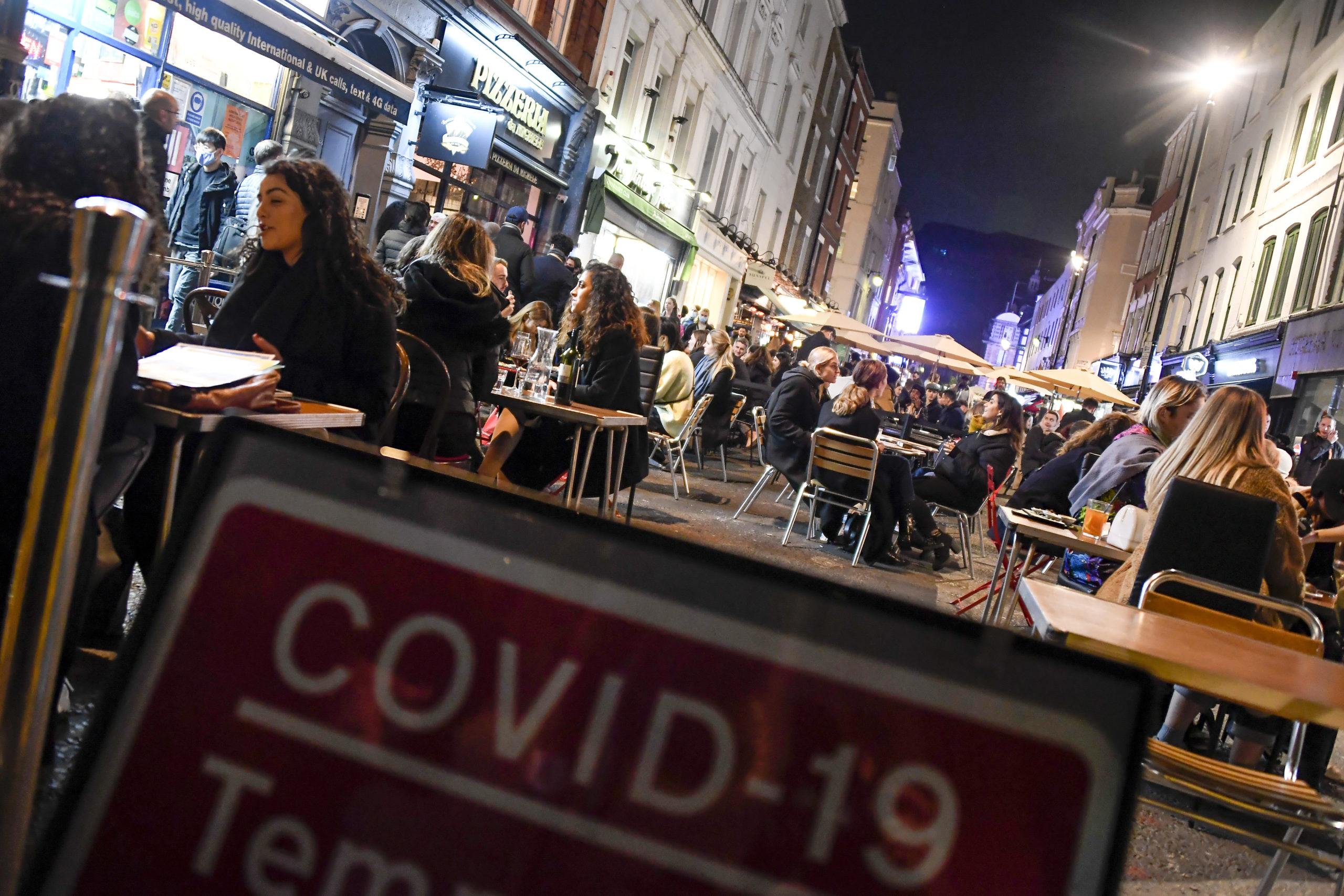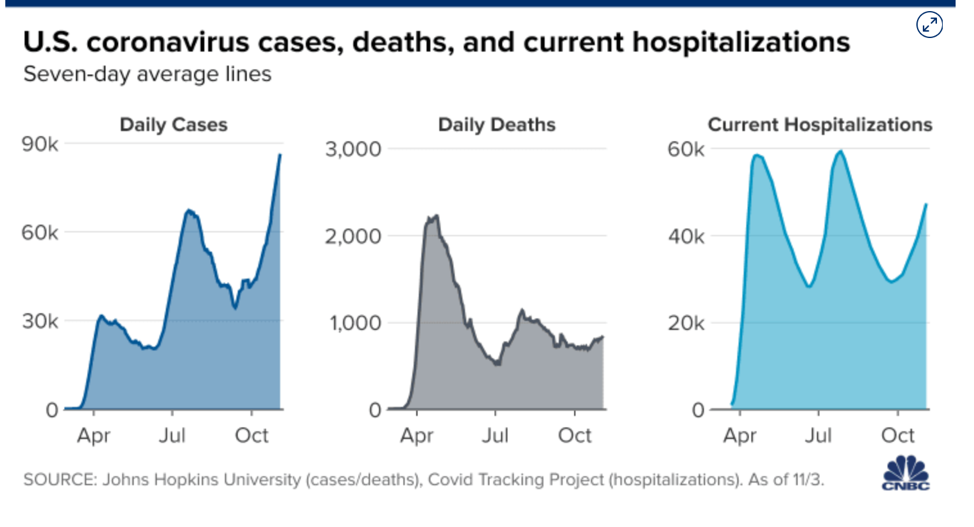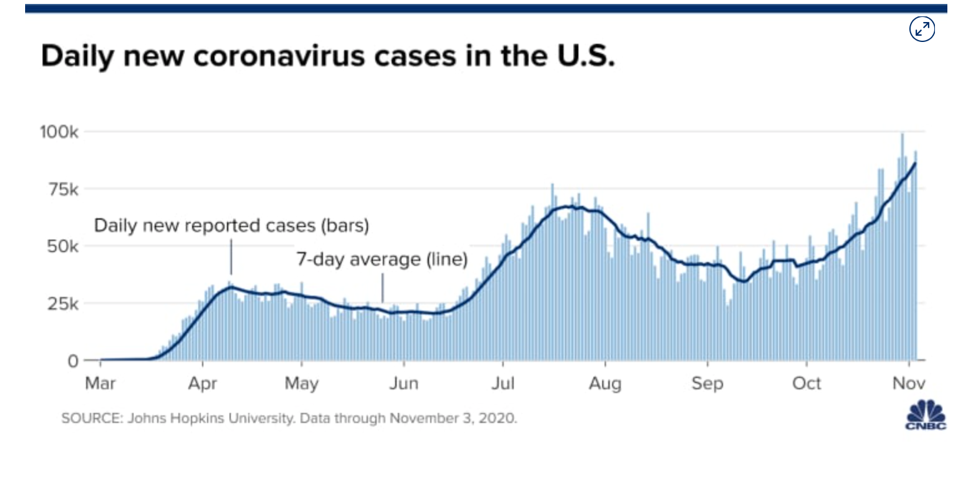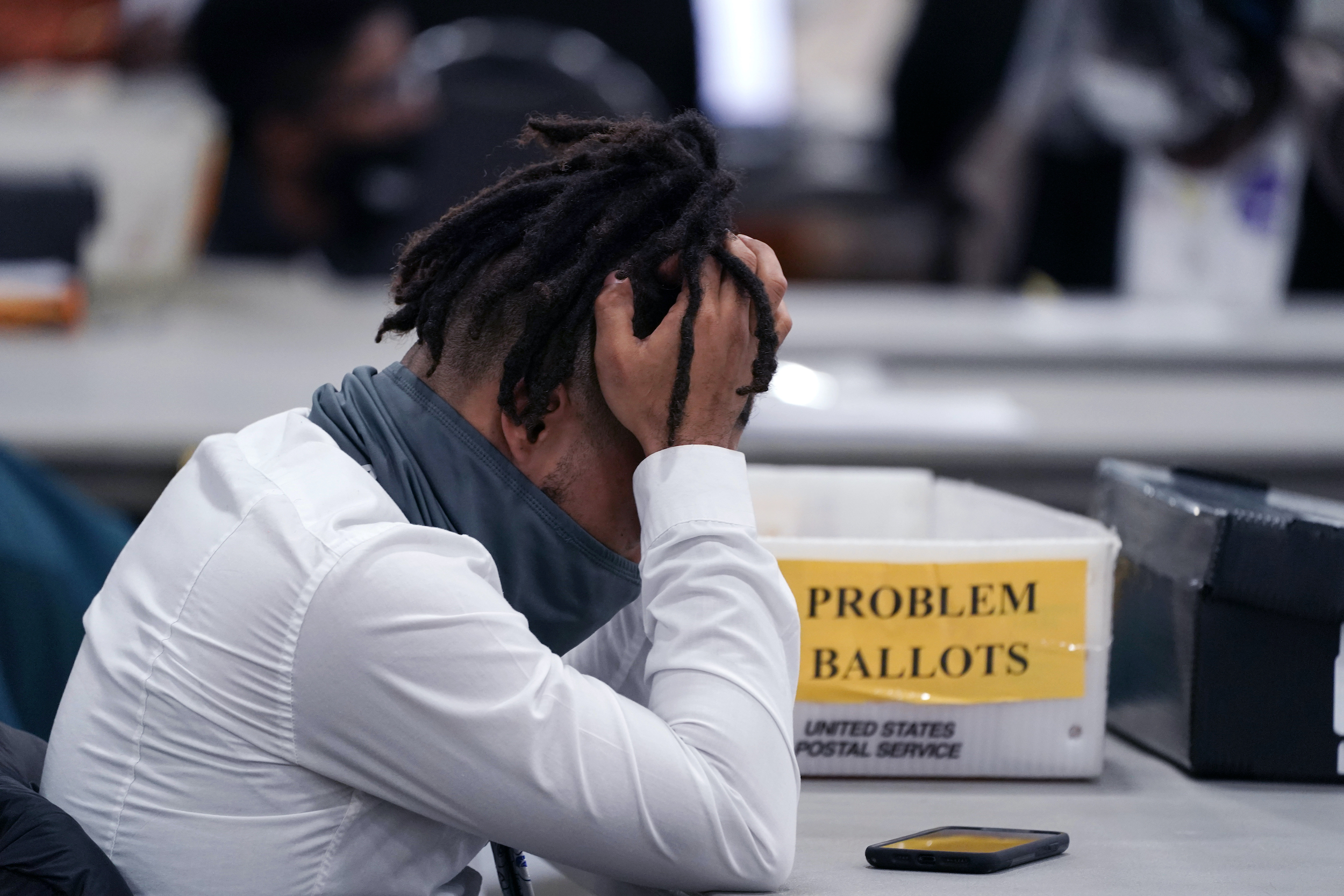 Covering COVID-19 is a daily Poynter briefing of story ideas about the coronavirus and other timely topics for journalists, written by senior faculty Al Tompkins. Sign up here to have it delivered to your inbox every weekday morning.
Covering COVID-19 is a daily Poynter briefing of story ideas about the coronavirus and other timely topics for journalists, written by senior faculty Al Tompkins. Sign up here to have it delivered to your inbox every weekday morning.
Even while you journalists sort through all of the counting, canvassing, recanvassing and recounting followed by lawsuits and appeals, other issues on our horizon are too big to ignore.
Today we look at some of those, including the U.S. officially pulling out of the Paris Agreement, some important down-ballot issues that voters decided about legalizing marijuana and drugs, and some police reform measures that arose since the death of George Floyd.
And you will see that a surprising number of kids who were never failing students are now that they are going to school virtually. We check in with mall retailers who are worried sick about the holiday shopping season and can look at whether Congress put aside differences post-election to rescue the economy.
And the really big news of the day: Will chicken thighs replace chicken wings? It is 2020, so why not just upset everything all at once? Let’s dive in.
The U.S. left the Paris Agreement Wednesday. A President Biden would rejoin.
Yesterday was not just the day after Election Day, it also was the day the United States formally dropped out of the Paris Agreement.
The next few days will determine whether the U.S. is part of a global effort to do something about controlling climate change. If Joe Biden wins the election, he says the U.S. would be back in the agreement, which President Barack Obama signed five years ago
President Trump said in 2017 that the U.S. would pull out of the agreement, which was signed by 189 countries. The agreement had the goal of keeping the increase of average global temperatures “well below” 2 degrees Celsius (3.6 degrees Fahrenheit) compared to pre-industrial levels. In many parts of America, temperatures have already risen above 2 degrees Celsius.
The Paris Agreement replaced the 1997 Kyoto Protocol, which addressed 37 nations and required them to reduce greenhouse gas emissions. The Paris Agreement expanded the responsibility to almost all nations and considered each country by its size, economic situation and how much the country contributes to climate change. But the Paris Agreement doesn’t have enforcement built into it and only parts of it were legally binding.
Biden has said that he would sign the U.S. back up to support the Paris Agreement. That would not require congressional approval, because it is an “executive agreement.” Biden would also likely reinstate many of the 160 Trump rollbacks of environmental rules, from automotive fuel standards to light bulbs and methane emissions.
The pandemic is growing

People eat and drink outside pubs and restaurants in Soho in London, Wednesday, Nov. 4, 2020. A second lockdown in England is set to come into force on Thursday. (AP Photo/Alberto Pezzali)
One of the mystifying facts from the election is that even as 21 states set new COVID-19 records, the pandemic was not the No. 1 issue on the minds of voters. Exit polls said one in six voters cited the pandemic as most important to their vote. In comparison, one-third of voters named the economy as their most critical issue and one in five cited racial equality.
The Johns Hopkins seven-day average of daily new cases now stands at 86,362 — 20% higher than last week’s levels. Missouri, Oklahoma, Iowa, Indiana, Nebraska, North Dakota and New Mexico all reported record high hospitalizations this week, according to The Associated Press.

(CNBC)

(CNBC)
As America determines who will lead the country through a growing pandemic, Europe is in the midst of a second widespread shutdown.
- Starting today, England begins a second lockdown with stores, pubs and restaurants closed for a month. Brits may only leave their homes if they are going out to buy needed supplies or if they are essential workers.
- Italians are imposing a 10 p.m. curfew. The BBC says Italy “will be divided into red, orange and green zones. The red zones — the areas with the highest level of infections — will have to close all bars, restaurants and most shops, including hairdressers and beauticians.”
- Switzerland just called in the military to help hospitals deal with the growing coronavirus spread.
- Poland and Lithuania are heading toward a new lockdown. The Netherlands has ordered a partial four-week lockdown.
- Germany closed theatres and gyms, and restaurants may only sell takeaway meals.
- The French health minister wants the country to extend its state of emergency until February.
It is noteworthy that on Election Day, America recorded its second-highest single-day number of new COVID-19 cases.
What does the election mean for stimulus chances?
This week is a hopeless week for any progress on a stimulus bill, but is there any chance that one could emerge soon?
If Republicans hold the Senate majority, that kills the chances for something called a reconciliation bill — which can pass with a simple majority — that might have happened when a new Congress is sworn in Jan. 3. There will likely have to be a bipartisan stimulus bill, some version of the proposals that House Democrats have tried to cook up with the White House since early summer.
CNet came up with a few scenarios that could unfold in the weeks ahead, partly dependent on who wins the presidential election:
A White House offer is completed after Nov. 3: An agreement is made and the current House and Senate vote. If Trump signs it into law, stimulus checks and other aid would likely begin to go out within weeks, with certain groups receiving financial help before the end of 2020.
A White House offer is finalized and fails in the Senate: In this situation, the House could vote on a deal after the election, but the current Senate, which is Republican-led, could vote it down, so the bill would not become law. In this case, Congress might try again after the next members of the House of Representatives and Senate convene on Jan. 3.
Some funding could be included in a bill that also funds the government past Dec 11: It’s possible that one piece of funding, for example a stimulus check, unemployment aid or an extension of the eviction stay, could make it into a bill to keep the government funded past Dec. 11 and avoid a shutdown.
Talks stop until after the election results are in: If talks grind to a halt after the election, it’s likely they’ll restart in some capacity after the inauguration in January. It’s been speculated that if Trump loses the election and if the Republican party loses its Senate majority, there will be little incentive for Congress to pass a sweeping package until 2021 during the transition.
Make no mistake, this is a hugely important issue for your readers, viewers and listeners as they face the end of eviction protections provided by the Centers for Disease Control and Prevention in less than two months.
Once again, it may be up to states to move when Congress can’t or won’t. CNet reported, “Colorado will give a one-time $375 stimulus check to nearly everyone who claimed unemployment from March to October. And its governor, Jared Polis, proposed a $1.3 billion stimulus plan for the state.”
Marijuana enthusiasts had a good election night
Arizona, Montana, New Jersey, and South Dakota all voted to legalize and tax recreational marijuana. The vote was close in South Dakota but was a blowout in the other states. This means that it will be legal (in one way or another) to recreationally smoke pot in 15 states plus the District of Columbia.
Two-thirds of Americans tell Pew pollsters they support legalizing marijuana. Some of the states that passed pro-pot measures played the approval as a tax generator. In New Jersey, supporters said it would help police to focus on other, more important matters.
Vice explained how this week’s decisions have a direct impact on arrests:
Matt Sutton, spokesman for the Drug Policy Alliance, said the support of drug reform is crucial in the context of wider conversations around police brutality and the failings of the criminal justice system.
He said Oregon’s decriminalization measure could result in a 95 percent decrease in racial disparities in arrests, according to the Oregon Criminal Justice Commission.
Sutton said it’s “remarkable” that weed legalization would pass in states like Montana, which has the highest rate of racial disparities in weed arrests, and South Dakota, where 10 percent of all arrests are tied to cannabis.
Oregon went a step further by legalizing small amounts of heroin, meth and cocaine. Oregon also legalized “magic mushrooms” for use in therapeutic settings. Mental health experts claim the compound in the mushrooms called psilocybin could help people struggling with issues from depression, anxiety and addiction. It will take a couple of years to work out the details on how to regulate the drug.
Vice adds some context to the vote:
The outcomes are a boon for drug reform advocates and the cannabis industry, making the possibility of federal weed decriminalization more feasible. Currently, 33 states allow medical cannabis and 11 have recreational regimes.
Several of the states that passed measures last night have historically been proponents of the war on drugs, with Black people disproportionately arrested for drug crimes.
Jones Bonner, who is Black and runs a hemp company, said the impact of the war on drugs on her family members is part of the reason she got involved collecting signatures in support of Initiative 65.
“People of color have been disproportionately demonized and incarcerated for this plant. In this era, people of non-color are capitalizing on the economic benefits of this plan and you still have people serving ridiculous sentences that will not be adjudicated,” Jones Bonner said, adding that many farmers in her home state are living in abject poverty.
Police reform was on the ballot around the country
Governing.com, a website aimed at local and state government leaders, tracked the many police reform proposals on ballots around the country. Here is a summary of how the proposals fared:
Philadelphia has approved the creation of a Citizens Police Oversight Commission with 75 percent voting in favor of the measure. (Results remain unofficial. Source: Ballotpedia)
In Pittsburgh, a measure has passed with 85 percent of the votes, amending the city charter to require police officers to cooperate with investigations by the Independent Citizen Police Review Board, which will have the authorization to audit the police bureau, and change board member removal procedures. (Ballotpedia)
In San Francisco, voters passed a measure in favor of amending the city and county charter to create the Sheriff’s Department Oversight Board which will be authorized to report findings and recommendations on department operations to the board of supervisors and to create the Sheriff’s Department Office of Inspector General to investigate non-criminal misconduct by employees and in-custody deaths and recommend policy changes to the sheriff and board of supervisors. The measure passed with 67.5 percent of the vote. (Ballotpedia)
San Diego’s Measure B to create a civilian review board appears to have passed with 75 percent of the vote. It would create a Commission on Police Practices, which would have members appointed by the City Council, its own staff, an independent attorney and the power to subpoena and conduct investigations into police officer misconduct. (KPBS)
Recanvas, recount — they are not the same

An elections worker rubs his head in the closing hours where absentee ballots were processed at the central counting board, Wednesday, Nov. 4, 2020, in Detroit. (AP Photo/Carlos Osorio)
It seems that the Trump team is going to press for some version of reviewing who voted for whom in some places. I have been hearing journalists using the words “recanvas” and “recount” interchangeably. They are different.
Recanvassing is essentially a routine review of vote totals performed county by county. Think of it as an audit that happens in some states as a matter of routine and other places only when a candidate requests it. In most states, only close races are eligible for recanvassing. The threshold varies state by state. This, for example, is Texas’ procedure. Here is Wisconsin’s recanvas law.
A recount, however, is a deeper retotaling of all of the votes in a county, or in select precincts. It usually involves a court order and includes an examination of the actual ballots. To remind yourself of how chaotic a recount can become, look back to 2000 and listen to tales from the people who were closely involved in that battle over Florida.
The National Conference of State Legislatures has a list of the key differences in state laws on reexamining election outcomes. In a few states, the vote totals for the top two candidates must be within a specified margin in order for the losing candidate to be able to request a recount. For example, in Idaho, a candidate may petition for a recount if the difference between the requesting and winning candidates is less than 0.1% of the total votes cast for the office. Here is a summary:
Seven states do not have a requested recount process: Connecticut, Florida, Hawaii, Illinois, Mississippi, New York, and South Carolina.
In two states, a recount may only be conducted by court order: Arizona and Tennessee.
In Massachusetts and Pennsylvania, recounts must be requested via a petition signed by a specified number of registered voters.
In the remaining 39 states, a candidate can request a recount. In 12 of these, the results must be within a specified margin for a candidate to request a recount: Delaware, Georgia, Missouri, Montana, New Hampshire, North Carolina, North Dakota, South Dakota, Texas, Utah, Vermont and Virginia.
In six states, political parties can request recounts under certain conditions: Colorado, Indiana, Michigan, Oregon, South Dakota, and Washington.
Voters can request a recount in eight states: Alabama, Alaska, California, Massachusetts, Nevada, New Jersey, Pennsylvania, and South Dakota.
In another seven states, voters can request a recount only on ballot questions (not candidate races): Montana, Ohio, Oklahoma, Oregon, Virginia, Washington, and Wisconsin.
Elections officials can order recounts under certain conditions in four states: California, Georgia, Oregon, and Wyoming.
In Colorado, the governing body referring a measure and a referendum or initiative petition sponsor can request a recount.
Who pays for recounts?
The NCSL says: “In most of the states that permit a candidate or other interested party to demand a recount, the petitioner is required to pay a deposit toward the cost of conducting the recount. If the recount reverses the result of the election, that person’s deposit is refunded. If the recount does not change election results, the petitioner is required to pay most of the costs associated with the recount. Automatic recounts are paid for by the state or county that conducts the recount.”
School attendance slips while failing grades grow with distance learning
The Los Angeles Times reported a trend that we had better all pay attention to:
Grades of D and F have increased in the Los Angeles Unified School District among middle and high school students in a troubling sign of the toll that distance learning — and the coronavirus crisis — is taking on the children, especially those who are members of low-income families.
The district released a chart Monday indicating that based on 10-week interim assessments, failing grades are increasing across the board, but are surging the most in lower-income communities. Compounding the disturbing trend, students in these same communities, hard hit by the spread of COVID-19, have the lowest attendance.
“The attendance figures and interim assessments don’t reflect the desire or capability of students,” said L.A. schools Supt. Austin Beutner in remarks recorded for broadcast Monday. “They’re eager to learn and every bit as capable as they were before school facilities closed. But the struggle to cope with COVID-19 and online learning for children and their families is very real.”
It is not just Los Angeles, as San Fransisco-based KCBS radio reports:
About four in ten high school students in Sonoma County have one or more failing grades, an upsurge since distance learning resumed this quarter due to the coronavirus pandemic.
Educators said they are alarmed because the increase comes amid an uptick in mental health issues among secondary students.
Recent data from Sonoma County’s high school district finds 37% of students have one or more failing grades, up 10% from this time last year. Among freshman, the rates have risen from 27% to 40%.
It is happening in Columbia, Missouri. And Hays County, Texas also is seeing an increasing number of failing grades during remote teaching. In some cases, it is because homework got caught up in the online system. Austin-based KXAN-TV reports:
“I was extremely confused because I usually have good grades,” said Javier Rodriguez.
But when the 8th grader got his progress reports last week, that wasn’t the case.
“All of a sudden, he was a 64 for two missing assignments with 100 at every other grade in that class,” said his mom, Tiffany.
The family realized the teacher hadn’t gotten some of their submitted assignments and was able to sort it out during a Zoom meeting.
“I had a daughter who was an all A/B student, failing five classes,” said Holly Cunningham, whose daughter attended Barton Middle School.
Her family didn’t even realize they had missed assignments.
Malls are in pandemic trouble

A closed JCPenney store is shown in Roseville, Mich., Friday, May 8, 2020. Across the country, in industries of every kind and size, the coronavirus COVID-19 pandemic has devastated businesses small and large. (AP Photo/Paul Sancya)
Once the election dust settles some, journalists will get back to reporting on the economy — especially the retail economy as the holiday shopping season begins. This week there is more evidence that malls are really struggling.
Two mall landlords, CBL Properties and Pennsylvania Real Estate Investment Trust, filed for bankruptcy. CBL catches the same ill wind as some of their tenants, including JCPenney, Ann Taylor-owner Ascena Retail Group, and Pier 1 Imports, all of which have filed bankruptcy during the pandemic.
It is projected that 25,000 stores could close this year as a result of the pandemic. By the end of next year, it is likely that more than half of the department stores that anchor trade in malls in the U.S. will be gone. During a time when purchasing shoes in person risks inflicting an unwitting form of violence against yourself and others, the evacuation of capital from commercial buildings is underway.
The website DeadMalls.com lovingly documents the ruins of former malls, with many visitors posting memories and photographs of places they had once shopped or worked. This nostalgia is particularly acute at a time when the sight of crowds of happy maskless strangers roaming through poorly ventilated concourses feels like it belongs to a lost golden age. The strange and troubled history of the U.S. shopping mall, however, is a reminder that even those who celebrate their passing should also be wary about what might replace them.
CNBC looks at what is thriving and what is not:
Apparel revenue is expected to drop industrywide by 20% to 30% this year, according to McKinsey & Co. Mass retailers such as Target and Walmart, on the other hand, are expected to see apparel revenue grow by 10% to 20% in 2020 compared with last year.
That sharp divide between retail’s haves and have-nots will make off-mall and “everything stores” more likely to thrive and specialty retailers more likely to struggle.
Chicken thighs to become the new wings — another 2020 thing
Somehow somebody convinced us that chicken wings, which used to be the throwaway part of a chicken, were the must-have snacks. But the chicken wing market is fickle and volatile so one of the big wing chains says it is going to try to steer customers toward bone-in thighs. It is so 2020 to throw this curve.
Wing prices are up 13% over a year ago, while other parts of the chicken are in a bit of an oversupply right now. Wholesale wing prices in the Northeast are at the highest since at least 2010, according to Department of Agriculture data.
KFC, Dominos and McDonalds have all jumped into the wings game and bars have found that if they offer spicy wings that beer sales go up. And yes, the chicken wing thing does have roots in Buffalo.
We’ll be back tomorrow with a new edition of Covering COVID-19. Sign up here to get it delivered right to your inbox.







